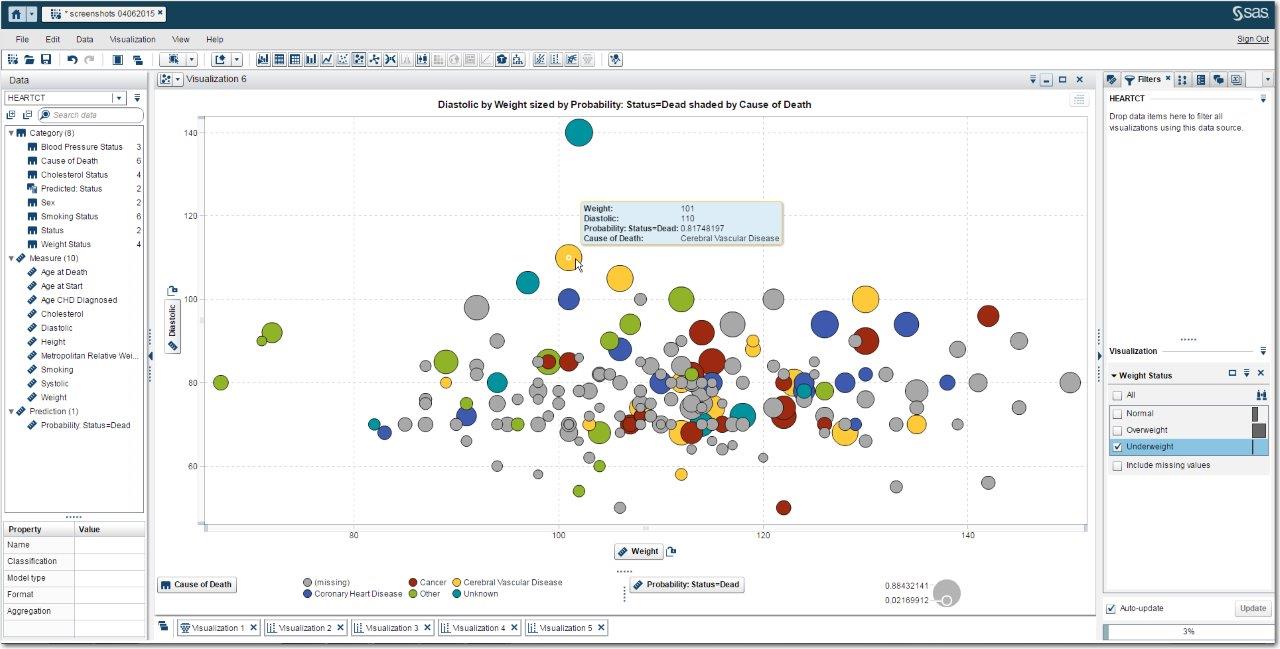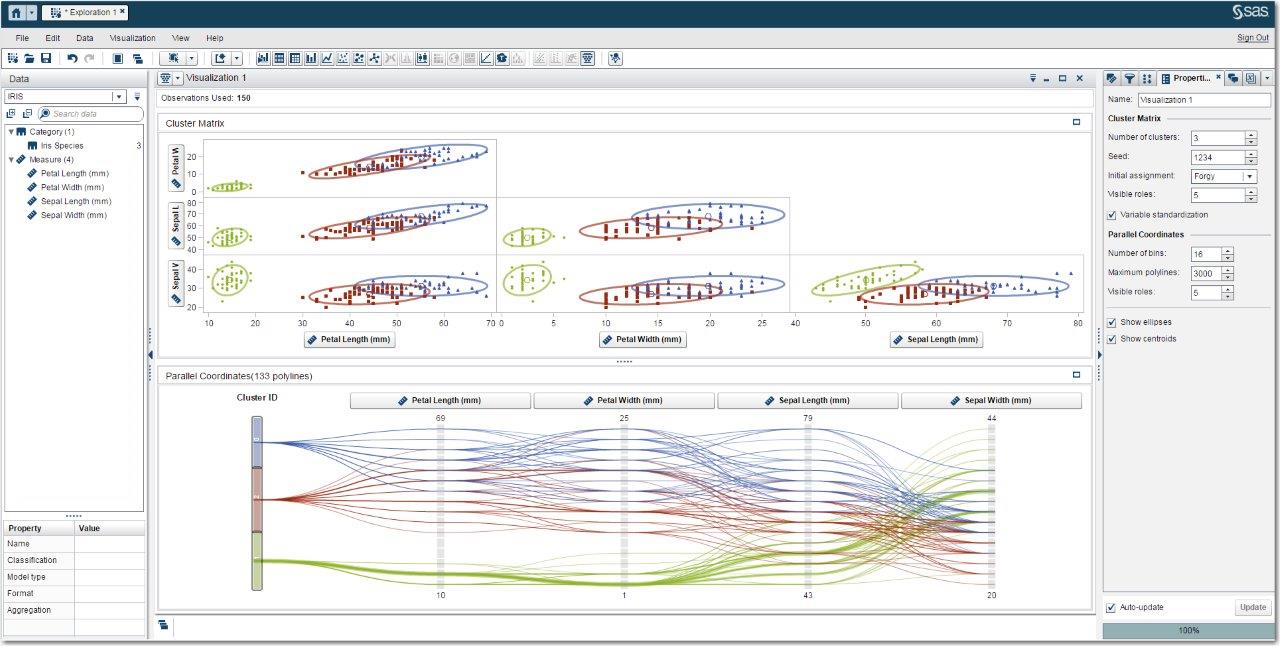- Home
- /
- SAS Communities Library
- /
- What is SAS Visual Statistics?
- RSS Feed
- Mark as New
- Mark as Read
- Bookmark
- Subscribe
- Printer Friendly Page
- Report Inappropriate Content
What is SAS Visual Statistics?
- Article History
- RSS Feed
- Mark as New
- Mark as Read
- Bookmark
- Subscribe
- Printer Friendly Page
- Report Inappropriate Content
As SAS Visual Analytics users – and proponents of data visualization in general – you appreciate the ability to put analytical insights in front of “consuming” users to make better decisions. “Consuming” users could be executives or directors or front-line staff like branch managers or online sales representative.
To get information in front of this set however, many of you rely on or collaborate with the “producing” users – those involved in exploring data and designing and building predictive models on a daily basis. “Producers” could be researchers, data scientists, statisticians, data miners, or business analysts, for example.
While there’s a need to expand this pool of core “producers,” it’s important for more marketing analysts, risk analysts, functional experts, and analytically “new” users (Gartner has recently called them “citizen data scientists”), to create and refine models as well. SAS Visual Statistics helps on this front.
If you haven’t heard about SAS Visual Statistics, let’s start with a quick overview.
- First, SAS Visual Statistics is an add-on product to SAS Visual Analytics.
- Second, it offers Web-based interactive, drag-and-drop interface that helps you build descriptive and predictive models. It takes advantage of SAS LASR Analytic Server for in-memory computations.
- Lastly, and importantly, it is now fully integrated and delivered through the SAS Visual Analytics Explorer 7.2 interface for a common end-user experience. This approach allows you to explore data before building or refining models. You can also explore the results (e.g. predicted values, labels, cluster ids) after building or refining models.
How do you start?
Begin in SAS Visual Analytics Explorer to analyze a number of areas including:
- Investigating the distribution of different variables.
- Understanding relationships among variables.
- Handling basic data manipulations, variable formatting and apply filters.
Then utilize SAS Visual Statistics for:
- Interactively building an analytical model directly from a chart (Scatter plot, Box plot, Heat Map & Correlation matrix) in only two clicks.
- Optionally stratifying the models to isolate specific segments.
- Developing challenger models and comparing multiple models to select a champion.
- Exploring the modeling results (e.g. predicted values, labels, cluster ids)
- Saving scoring code to score new customer cases.
Sample SAS Visual Analytics exploration
(click to enlarge)

Sample SAS Visual Statistics models
(click to enlarge)

(click to enlarge)

Key capabilities of SAS Visual Statistics:
- Predictive Modeling Techniques.
- Linear regressions.
- Logistic regressions.
- Generalized linear models.
- Descriptive Modeling Techniques.
- Clustering.
- Classification trees.
- Dynamic Group-by Processing
- Model Comparison and Assessment.
- Model Score Code.
With a combined, fully integrated data discovery (i.e., SAS Visual Analytics) and predictive modeling (i.e., SAS Visual Statistics) approach, you can improve collaboration and productivity of “producers” and “consumers.”
Want to give SAS Visual Statistics a whirl? Try it out and let us know what you think.
- Mark as Read
- Mark as New
- Bookmark
- Permalink
- Report Inappropriate Content
Nice summary outlining the collaborative toolsets...
- Mark as Read
- Mark as New
- Bookmark
- Permalink
- Report Inappropriate Content
What is the benefits and differences between Enterprise Miner and Visual Statistics? Our Statisticians are using EM.
- Mark as Read
- Mark as New
- Bookmark
- Permalink
- Report Inappropriate Content
Visual Statistics (VS) is a web client based product that supports interactive ad-hoc data analysis whereas Enterprise Miner (EM) is a rich client with more of a batch type interface for developing repeatable analysis through the process flow diagram. VS is also targeted to both novice analysts with some very fundamental understanding of regression modeling and to a lesser extent advanced users. EM tends to be more targeted more towards advanced data miners and scientists with lots more algorithmic depth. One common use case I am seeing is use VS prior to modeling for feature reduction through the interactivity the product provides using all of the data and then fine tune the model in EM. VS generates SAS score code so you can compare models in EM using the Model Import node. Once use case I am not seeing enough is using VS to do post ad hoc validation of models – say evaluating score band cutoffs interactivity and evaluating high leverage and influence points even with real big data. You may also want to use VS to derive segments interactively and the use the Group Processing feature of EM to do stratified modeling. It is a great question – I hope this helps some. I was the EM product manager for over a decade and now am working on VS. I still love both products and use them all the time.
April 27 – 30 | Gaylord Texan | Grapevine, Texas
Registration is open
Walk in ready to learn. Walk out ready to deliver. This is the data and AI conference you can't afford to miss.
Register now and lock in 2025 pricing—just $495!
SAS AI and Machine Learning Courses
The rapid growth of AI technologies is driving an AI skills gap and demand for AI talent. Ready to grow your AI literacy? SAS offers free ways to get started for beginners, business leaders, and analytics professionals of all skill levels. Your future self will thank you.
- Find more articles tagged with:
- exploratory_analysis
- predictive_analytics
- predictive_modeling
- visual_analytics
- visual_analytics_explorer
- visual_statistics
